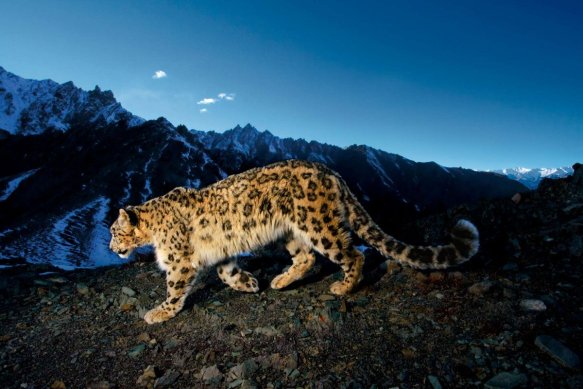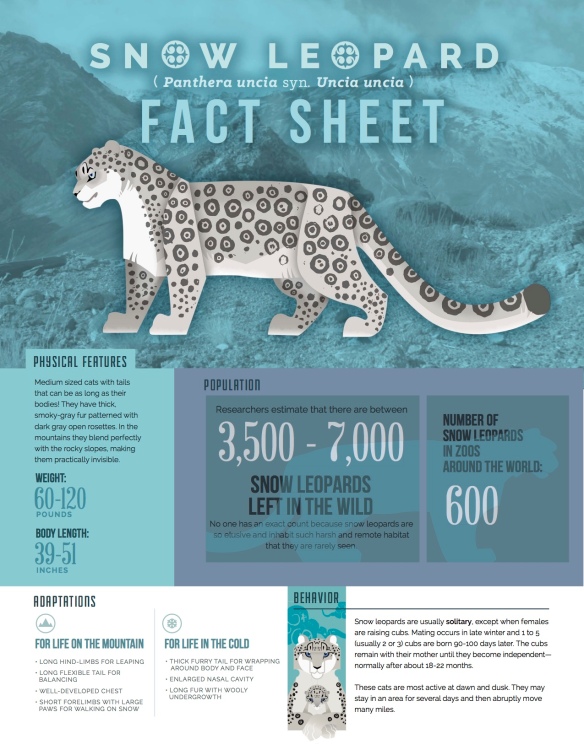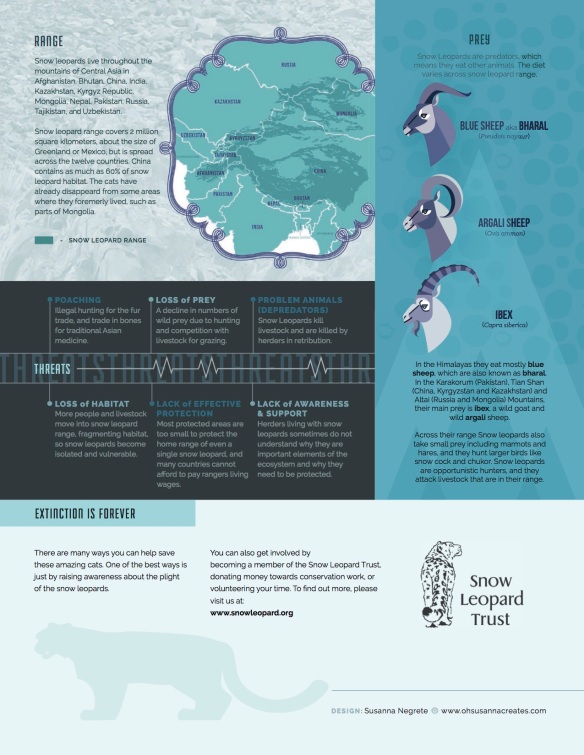Panthera uncia, or the Snow Leopard, is a gorgeous and rare cat that lives in the mountains of Central Asia. I have long been fascinated with these mysterious and other worldly cats who seem to exude a sense of intangible wisdom and calm, perhaps this is a direct result of having evolved to live in such a harsh and remote environment. The mysterious quality is well earned as they are very hard to photograph and study. In fact, most of the photos taken of Snow Leopards are done with strategically placed camera traps, making images like the one by wildlife photographer Steve Winter, extremely breathtaking and precious.

One of the most elusive of the big cats & rarest photographed – Image Steve Winter
Snow Leopards are known for their mystical beauty and elusive nature, and because of this they have been called the Ghost of the Mountains. Part of their allure is their fur, which is luxuriously beautiful and practical at keeping them perfectly warm and camouflaged in the rugged and unforgiving landscape in which they live and hunt. While Snow Leopards are found in 12 countries approximately 60% of the cats habitat can primarily be found in China.

The snow leopard has white, yellowish and smoky grey speckled fur with dark-grey to black spots and rosettes. Image – Snow Leopard Trust
As with all cats they have physical characteristics that suit their environment, and their features do more than present a pretty picture, they serve a purpose. The round short ears help reduce heat loss and the wide and short nasal cavity heat the chilled outside air before reaching the lungs. “In the Himalayas, they are usually found between 3,000 and 5,400 meters above sea level. In Mongolia and Russia, these cats are found at lower altitudes of 1000 meters. At the Snow Leopard’s typical elevation, the climate is cold and dry, and only grasses and small shrubs can grow on the steep mountain slopes.”

Snow leopards prefer the broken terrain of cliffs, rocky outcrops, and ravines. Image – Steve Tracy, Courtesy of the Snow Leopard Trust
Other physical features that make Snow Leopards suited for its extreme environment include: extra big paws that act like snow shoes; a long tail that is used for balance and also keeping warm on cold nights; short front limbs and long back limbs which are used to help the cat propel itself up to 30 feet at once and, very strong chest muscles to help it climb mountains for prey.
Since Snow Leopards are hard to study researchers have relied on camera trap technology which has helped them understand more about the cats than ever before. However, their ghost like presence has still made it impossible to determine exactly how many exist and, estimates have put this endangered cat at only 3,500 – 7,000 individuals. Snow Leopards are listed on CITES Appendix I which offers the highest level of protection and means all international trade that is primarily for commercial purposes is prohibited. They are also legally protected from hunting by national legislation across most of its 12 range states and, in 2009 Afghanistan gave the cats legal protection by listing the species on the country’s first Protected Species List.

The Snow Leopard Trust has documented one cat who walked 27 miles in just one night.
While Snow Leopards tend to be ‘crepuscular’, meaning they are most active at dawn and dusk their behavior has noted to be influenced by the presence of humans. It has been found that were there is less human population they are active in the daytime and when there are more people nearby their territory, they become ‘nocturnal’ or active at night.
The cats communicate over vast distances either by marking, which is done by scraping the ground, or spraying urine on ridges and cliffs along the mountains. Solitary animals, once mating season is over the male and female part ways leaving her to raise the cubs until they reach about 2 years old at which time the cubs will leave to look for their own territory. A Snow Leopards territory can be hundreds of square km and overlap but, researchers believe that the amount of space each cat needs may differ between the landscapes and availability of prey.

Snow Leopards from the Zurich Zoo – Image Flickr
While Snow Leopards can purr, mew, hiss and growl they cannot roar instead, they are known to make a puffing sound called a ‘chuff’ just like Tigers. The ability to roar does not exist in Snow Leopards due to the physiology of their throat, or structure of the hyoid bone. To hear what the chuffing sounds like check out this video of a Snow Leopard from Big Cat Rescue.
What is also important to note is that these cats are not aggressive towards humans and, there has never been a confirmed Snow Leopard attack on a human being. Instead they have a reputation for running away rather than defending themselves if disturbed. Like all cats, they may however become aggressive during an encounter between two males or if a female’s cubs are being threatened.
While Snow Leopards may not be the most photographed of the big cats, never before seen footage has been released in time to celebrate International Snow Leopard Day which is marked today October 23. The WWF has released photos and video to coincide with a report that highlights the fragile connections between Snow Leopards, People, Water And The Global Climate. They say that a third of the cats habitat is at risk from climate change. Images in this video were taken in Nepal and Mongolia.
As with all our big cats human activity is a major threat to the survival of this species, this includes poaching for their fur, retaliatory killings for livestock loss, loss of habitat and prey, mining activities and lack of resources to protect the cats. If that wasn’t enough, climate change will now add another immediate threat to the survival of Snow Leopards. WWF-UK tells International Business Times that “The Himalayas region will face a major crisis if we choose to ignore climate change. Not only do we risk losing majestic species such as the snow leopard, but hundreds of millions of people who rely on water flowing from these mountains may be affected.”
The leading organization on these cats the Snow Leopard Trust, founded in 1981, is at the forefront working diligently to save them while offering ways for people to help Snow Leopards by either donating, volunteering, shopping or becoming a partner. They also have a wealth of resources about their work and research available online including their report on how Climate Change could speed up the Snow Leopards demise.
The Snow Leopard Trust has put together this wonderful two-part infographic fact sheet which can be shared and downloaded from their site, it is a great educational tool to inform others of this amazing cats plight and help them understand why they are worth saving.



Pingback: Ghosts of the mountains endangered big cat | From guestwriters
Pingback: Ghost of the Mountain — | huggers.ca